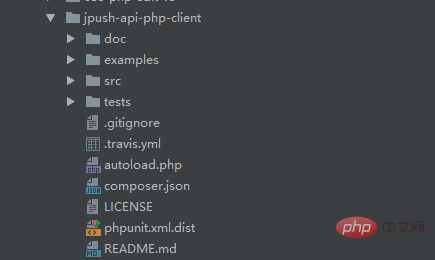
Cet article parle principalement de l'utilisation du framework Yii pour simuler la notification de message push PHP Aurora. Il a une certaine valeur de référence. Les amis intéressés peuvent en apprendre davantage.
1. Téléchargez le SDK PHP Aurora Push, décompressez-le et placez-le dans le répertoire /protected/components/, comme indiqué ci-dessous :

2. Améliorer les modifications Prenons l'exemple de la démo officielle. Je copie une démo ici et la change en NotifyPush.php, avec le code suivant :
<?php
require dirname(__FILE__) . '/jpush-api-php-client/autoload.php';
use JPush\Client as JPush;
class NotifyPush {
static function pushAlias($alias,$ticket='消息提醒',$alert){
$appKey=Yii::app()->params['push']['AppKey'];
$appMasterSecret=Yii::app()->params['push']['AppMasterSecret'];
$production_mode=Yii::app()->params['push']['production_mode'];
$client = new JPush($appKey, $appMasterSecret);
// 完整的推送示例
// 这只是使用样例,不应该直接用于实际生产环境中 !!
try {
$response = $client->push()
->setPlatform(array('ios', 'android'))
// 一般情况下,关于 audience 的设置只需要调用 addAlias、addTag、addTagAnd 或 addRegistrationId
// 这四个方法中的某一个即可,这里仅作为示例,当然全部调用也可以,多项 audience 调用表示其结果的交集
// 即是说一般情况下,下面三个方法和没有列出的 addTagAnd 一共四个,只适用一个便可满足大多数的场景需求
->addAlias($alias)
->setNotificationAlert($alert)
->iosNotification($ticket, array(
'sound' => 'sound.caf',
// 'badge' => '+1',
// 'content-available' => true,
// 'mutable-content' => true,
'category' => 'jiguang',
'extras' => array(
'key' => 'value',
'jiguang'
),
))
->androidNotification($ticket, array(
'title' => $alert,
// 'build_id' => 2,
'extras' => array(
'key' => 'value',
'jiguang'
),
))
->message($alert, array(
'title' => $alert,
// 'content_type' => 'text',
'extras' => array(
'key' => 'value',
'jiguang'
),
))
->options(array(
// sendno: 表示推送序号,纯粹用来作为 API 调用标识,
// API 返回时被原样返回,以方便 API 调用方匹配请求与返回
// 这里设置为 100 仅作为示例
// 'sendno' => 100,
// time_to_live: 表示离线消息保留时长(秒),
// 推送当前用户不在线时,为该用户保留多长时间的离线消息,以便其上线时再次推送。
// 默认 86400 (1 天),最长 10 天。设置为 0 表示不保留离线消息,只有推送当前在线的用户可以收到
// 这里设置为 1 仅作为示例
// 'time_to_live' => 1,
// apns_production: 表示APNs是否生产环境,
// True 表示推送生产环境,False 表示要推送开发环境;如果不指定则默认为推送生产环境
'apns_production' => $production_mode,
// big_push_duration: 表示定速推送时长(分钟),又名缓慢推送,把原本尽可能快的推送速度,降低下来,
// 给定的 n 分钟内,均匀地向这次推送的目标用户推送。最大值为1400.未设置则不是定速推送
// 这里设置为 1 仅作为示例
// 'big_push_duration' => 1
))
->send();
print_r($response);
} catch (\JPush\Exceptions\APIConnectionException $e) {
// try something here
print $e;
} catch (\JPush\Exceptions\APIRequestException $e) {
// try something here
print $e;
}
}
static function pushAll($ticket='消息提醒',$alert){
$appKey=Yii::app()->params['push']['AppKey'];
$appMasterSecret=Yii::app()->params['push']['AppMasterSecret'];
$production_mode=Yii::app()->params['push']['production_mode'];
$client = new JPush($appKey, $appMasterSecret);
// 完整的推送示例
// 这只是使用样例,不应该直接用于实际生产环境中 !!
try {
$response = $client->push()
->setPlatform(array('ios', 'android'))
->setAudience('all')
// 一般情况下,关于 audience 的设置只需要调用 addAlias、addTag、addTagAnd 或 addRegistrationId
// 这四个方法中的某一个即可,这里仅作为示例,当然全部调用也可以,多项 audience 调用表示其结果的交集
// 即是说一般情况下,下面三个方法和没有列出的 addTagAnd 一共四个,只适用一个便可满足大多数的场景需求
->setNotificationAlert($alert)
->iosNotification($ticket, array(
'sound' => 'sound.caf',
// 'badge' => '+1',
// 'content-available' => true,
// 'mutable-content' => true,
'category' => 'jiguang',
'extras' => array(
'key' => 'value',
'jiguang'
),
))
->androidNotification($ticket, array(
'title' => $alert,
// 'build_id' => 2,
'extras' => array(
'key' => 'value',
'jiguang'
),
))
->message($alert, array(
'title' => $alert,
// 'content_type' => 'text',
'extras' => array(
'key' => 'value',
'jiguang'
),
))
->options(array(
// sendno: 表示推送序号,纯粹用来作为 API 调用标识,
// API 返回时被原样返回,以方便 API 调用方匹配请求与返回
// 这里设置为 100 仅作为示例
// 'sendno' => 100,
// time_to_live: 表示离线消息保留时长(秒),
// 推送当前用户不在线时,为该用户保留多长时间的离线消息,以便其上线时再次推送。
// 默认 86400 (1 天),最长 10 天。设置为 0 表示不保留离线消息,只有推送当前在线的用户可以收到
// 这里设置为 1 仅作为示例
// 'time_to_live' => 1,
// apns_production: 表示APNs是否生产环境,
// True 表示推送生产环境,False 表示要推送开发环境;如果不指定则默认为推送生产环境
'apns_production' => $production_mode,
// big_push_duration: 表示定速推送时长(分钟),又名缓慢推送,把原本尽可能快的推送速度,降低下来,
// 给定的 n 分钟内,均匀地向这次推送的目标用户推送。最大值为1400.未设置则不是定速推送
// 这里设置为 1 仅作为示例
// 'big_push_duration' => 1
))
->send();
print_r($response);
} catch (\JPush\Exceptions\APIConnectionException $e) {
// try something here
print $e;
} catch (\JPush\Exceptions\APIRequestException $e) {
// try something here
print $e;
}
}
}3. Appelez la méthode dans NotifyPush.php pour implémenter le push, comme suit :
class CronNotifyPushCommand extends CConsoleCommand{
public $keys=array();
public function init(){
parent::init();
}
public function actionIndex(){
echo 'start CronNotifyPushCommand '.chr(10);
if(!Yii::app()->params['push']['push_status']){
echo 'push status disabled';die();
}
$rkey='message_notify_list';
$waitTotals=Fredis::model()->redis->lsize($rkey);
echo 'wait totals:'.$waitTotals.chr(10);
$waitResult=true;
$i=0;
while($waitResult) {$i++;
echo $i.'/'.$waitTotals.' wait to do'.chr(10);
$waitResult=Fredis::model()->redis->rpop($rkey);
if(!$waitResult) {
continue;
}
$db_data=unserialize($waitResult);var_dump($db_data);
$message_content=$db_data['message_content'];
$uid=$db_data['uid'];
$alias=$uid;
if($uid==0){
NotifyPush::pushAll($message_content, $message_content);
}else {
NotifyPush::pushAlias($alias, $message_content, $message_content);
}
}
echo 'end'.chr(10);
}
}Tutoriels associés : Tutoriel vidéo PHP
Ce qui précède est le contenu détaillé de. pour plus d'informations, suivez d'autres articles connexes sur le site Web de PHP en chinois!
 Quelle est la raison pour laquelle l'écran de l'ordinateur est noir mais l'ordinateur est allumé ?
Quelle est la raison pour laquelle l'écran de l'ordinateur est noir mais l'ordinateur est allumé ?
 Comment créer des graphiques et des graphiques d'analyse de données en PPT
Comment créer des graphiques et des graphiques d'analyse de données en PPT
 Comment vérifier l'utilisation de la mémoire JVM
Comment vérifier l'utilisation de la mémoire JVM
 Annuler le mot de passe de mise sous tension sous XP
Annuler le mot de passe de mise sous tension sous XP
 Introduction à la signification d'une syntaxe invalide
Introduction à la signification d'une syntaxe invalide
 Comment apprendre le langage go à partir de 0 bases
Comment apprendre le langage go à partir de 0 bases
 La différence entre TCP et UDP
La différence entre TCP et UDP
 Dernières cotations Bitcoin
Dernières cotations Bitcoin